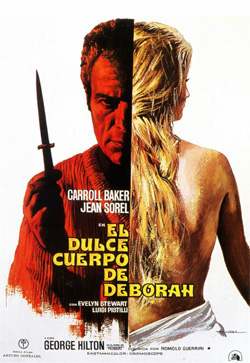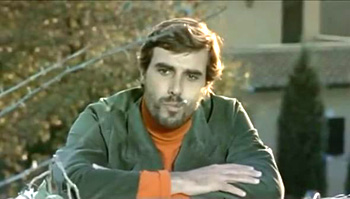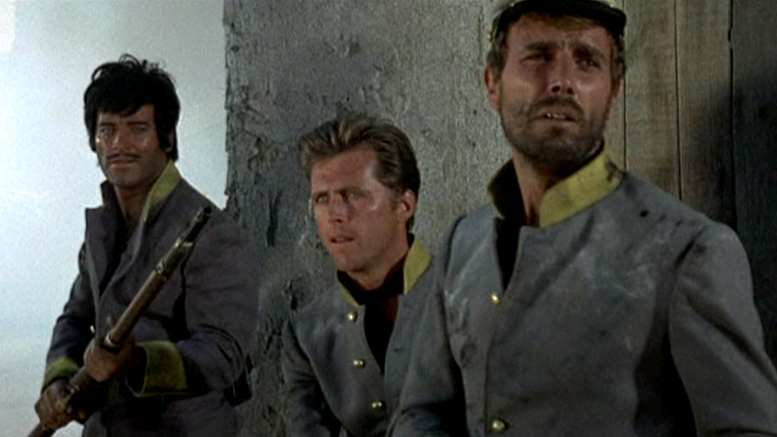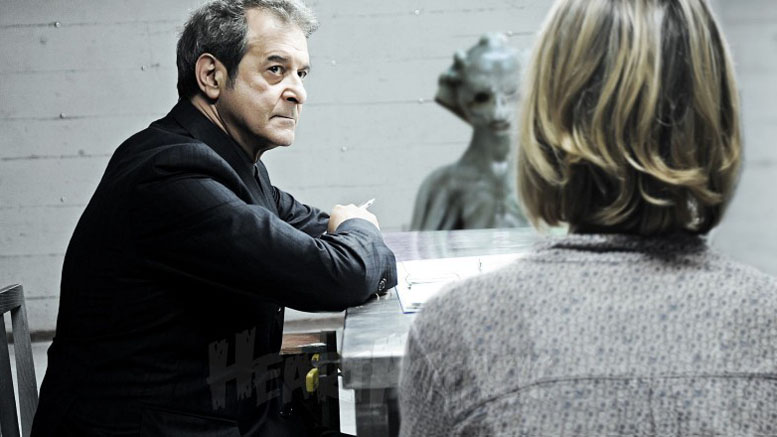aka Il dolce corpo di deborah (US), L’adorable corps de Deborah (Fr), Der schöne Körper der Deborah (WG)
Italy
1968
Mino Loy and Luciano Martino for Zenith Cin.ca, Flora Film (Rome), Lux C.C.F. (Paris)
Director: Romolo Guerrieri
Script: Ernesto Gastaldi, Luciano Martino
Music: Nora Orlandi (C.A.M.)
Cinematography: Marcello Masciocchi {Cromoscope – Eastmancolor}
Editor: Mariano Arditi
Set designer: Demofilo Fidani
Cameraman: Gino Santini
Filmed: Incir-De Paolis
Release information: Registered 15.03.68. Italy (20.03.68, 95 mins), France (06.02.69, 95 mins), Germany (12.07.68, 95 mins)
Cast : Carroll Baker (Deborah), Jean Sorel (Marcel), George Hilton (Robert), Luigi Pistilli (Philip), Evelyn Stewart [Ida Galli] (Susanna Boileau), Michel Bardinet (the Commissioner), Valentino Macchi (a garage owner), Renato Montalbano (a telephone repairman), Mirella Pamphili (the telephone clerk), Domenico Ravenna (a doctor), Giuseppe Ravenna (a maitre d’).

At one point in this film Carroll Baker and Jean Sorel engage in a swift game of twister. This is appropriate, not only because at the time Ms. Baker is wearing an utterly ghastly lime green body stocking, but also because The Sweet Body of Deborah is rather similar, in a metaphorical sense, to that mind enlarging pastime. As soon as you have mentally steadied yourself in relation to the component characters you are asked – nay, forced – to realign yourself as yet another disorientating plot development is thrown in.
Marcel and Deborah (the aforementioned actors) are a young couple honeymooning in Europe. After much soft focus petting and lovey-dovey stuff, they decide to go to Geneva, the city where he grew up. This turns out to be a less than brilliant idea, for they soon bump into a rather browned off friend of his, Philippe (Luigi Pistilli). The reason for this ire is that Marcel’s ex had killed herself in desperation after he left to seek his fortune in America. Consumed by guilt, he decides to visit her parent’s house, but finds it deserted. While searching around several strange things happen; lighted cigarettes appear in ashtrays, a haunting piano melody is heard and a death threat is delivered from a disconnected telephone.
Understandably, the ardour of the newlyweds cools somewhat. This is even more unsurprising given the fact that his idea of a romantic evening out is to visit a strip club or see a boxing match. In an attempt to rekindle the spirit of their trip they hire a villa in Nice. Carroll attempts to entice her husband into the bedroom by stating “Here’s the most important room in the house…” Jean replies “What, the kitchen?” (?!?). One bad move can be considered inopportune, but two are something else entirely. No sooner have they settled down with some nice martinis than George Hilton appears leering over the garden wall, gibbering on about being the serpent to their Adam and Eve.
From this point on everything becomes exponentially complicated. The relationship between the protagonists (and between the audience and the protagonists) is continually altered and played upon. All actions are designed to push us into re-evaluating our impression as to what exactly is going on. The climactic revelations are satisfactory and cynical in equal measures, and the whole thing is surprisingly bloodless, relying upon tension and confusion to instill its effectiveness.

In many ways The Sweet Body of Deborah can be seen as an archetypal pre-Argento giallo. The motivating factors are greed, lust and hatred rather than pseudo-psychological disturbance. The photography is at times experimental, using fragmented lenses and illuminating shadow techniques. The music is surprisingly wistful, prominently featuring soft, wordless female vocals. The influence of Antonioni’s Blow Up (66) is interesting. An attempt to be an anti-thriller, it actually succeeded in kick-starting an entire brace of the types of films it was criticizing. It also introduced the psychedelic trappings that would be exaggerated as time passed on. Here we are treated to some very silly costumes and an outrageous disco scene. Someday I am finally going to get around to writing my epic thesis upon ‘The History Of Popular Culture As Espoused Within Night-club Sequences Of Modern Cinema’, but after watching this I am to busy picking up my digestive tract and thrusting it back into my ruptured sides. The phrase “chicken on a hot-wire” has never been more appropriate.
The superb (and small) cast also scores top marks. This was Carroll Baker’s first Italian thriller after fleeing from a broken marriage and the debacle that was Harlow in Hollywood. So good is she in this that she went on to play the same ‘superficially vulnerable but actually…’ role in about another 10 films. George Hilton plays the first of many untrustworthy smoothies and Jean Sorel is fine as the somewhat beleaguered husband. Romolo Guerrieri can be seen as a craftsman rather than a visionary, but there isn’t necessarily wrong with that. His impressive filmography also includes two other thrillers (The Detective (Un detective, 69) and The Double (La controfigura, 71)) both of which are well worth investigating. In an interview with Nocturno Magazine he recalled that: “the producer Luciano Martino – who did a lot of films with Mino Loy -called me and asked if I’d read a screenplay. I wasn’t overly taken with it, but it was The Sweet Body of Deborah. Martino said: ‘Look, how about if I get you Carroll Baker and Jean Sorel as the leads?’. Well, Sorel was a star back then because he’d just done a film with Visconti, and Carroll Baker was famous for Baby Doll. In short, they were two actors with ‘weight’. The film was a giallo, with numerous plot twists. So I did it, and it all went very well… At first I was a little lazy about shooting the film, but then I took a more experimental approach with the camera. So, although I didn’t like the story too much initially, at the end it had been demonstrated to be a valid screenplay. It was considered one of the best of the Italian gialli, and there’s some truth in that.”
8/10


I have been reading reviews of THE SWEET BODY OF DEBORAH, trying to get a sense of it. I an intrigued by Giallo films and wanting to get more for my collection. I am interested in this film – it does seem to have great style, at the very least.? Would you say this is quite a good film then? Another film I notice with Carrol Baker that sounds interesting is A Quiet Place to Kill.
Yes, it’s a very good film of its type. It’s not perhaps as ‘culty’ as the likes of Don’t Torture a Duckling or The Bird with the Crystal Plumage, but it’s a very solid and stylish erotic thriller (rather than a psycho thriller).